List of 15 Owls Species In Arizona
- Great Horned Owl – Large and adaptable, known for its ear tufts and deep hoot.
- Barn Owl – Heart-shaped face, often found in farmlands and grasslands.
- Elf Owl – World’s smallest owl, living in desert cacti.
- Western Screech Owl – Small with a trilling call, common in forests and deserts.
- Burrowing Owl – Day-active, lives in grasslands and uses mammal burrows.
- Northern Pygmy Owl – Tiny but bold, with “eye spots” on its head.
- Long-eared Owl – Slender with long ear tufts, prefers dense forests.
- Short-eared Owl – Day-active, often seen flying low over open fields.
- Spotted Owl – Rare, dark-speckled, prefers old-growth forests.
- Mexican Spotted Owl – Found in canyons, a subspecies of Spotted Owl.
- Northern Saw-whet Owl – Tiny, secretive, with a “tooting” call.
- Flammulated Owl – Small with flame-like markings, found in pine forests.
- Whiskered Screech Owl – Trilling call, prefers dense mountain forests.
- Ferruginous Pygmy Owl – Day-active and reddish-brown, found in deserts.
- Great Gray Owl – Tallest owl with a large facial disk, found in remote forests.
Arizona is a fantastic place for bird lovers, especially those who are interested in owls. The state has many types of owls, each with its own special features and habits.
15 Owls Species in Arizona
From the big and powerful Great Horned Owl to the tiny Elf Owl, Arizona’s different environments are great places for these amazing birds. In this article, we will explore the many owl species in Arizona, where you might find them, and some cool facts about each one. Whether you are a skilled birdwatcher or just getting started, learning about Arizona’s owl will definitely be an exciting adventure!
1. Great Horned Owl
Scientific Name: Bubo virginianus
Size: 46–63 cm (18–25 in)
Weight: 910–2,500 g (2–5.5 lbs)
Lifespan: 13–15 years in the wild
Diet: Small mammals, birds, reptiles, and insects
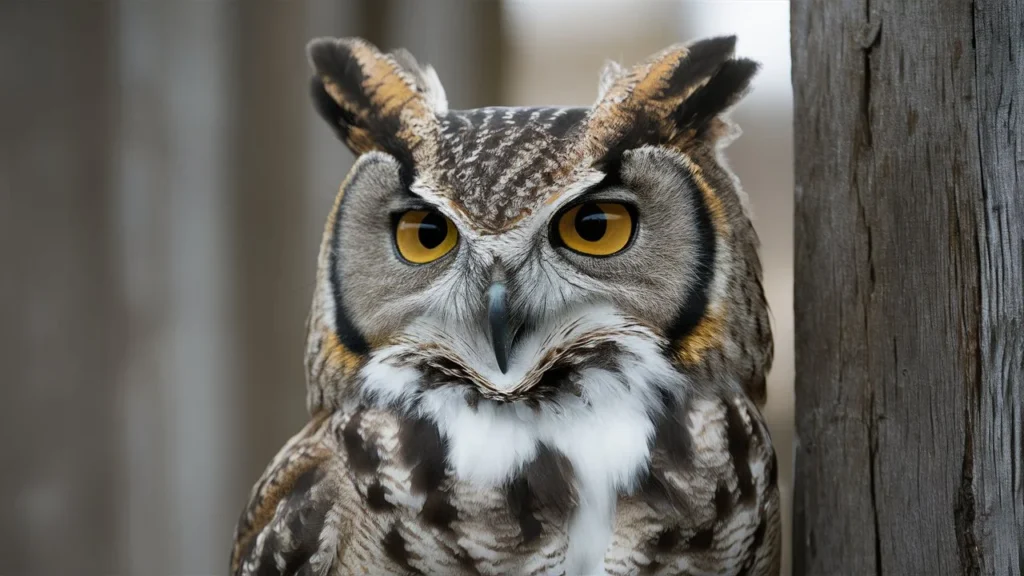
Appearance
The Great Horned Owl has a powerful, striking look. It’s known for its large size, bright yellow eyes, and the distinct “horns” or feather tufts on its head. Its feathers are a mix of brown, gray, and white, helping it blend into trees and rocky areas.
Hunting and Feeding Habits
A skilled hunter, the Great Horned Owl hunts mainly at night. It swoops down silently to catch prey, which includes rabbits, squirrels, and even skunks. Its sharp talons and strong beak make it easy for this owl to capture and eat its food.
Nesting
Great Horned Owls don’t build their own nests. Instead, they often use nests built by other birds or find a safe spot on a cliff or tree ledge. They are known to fiercely protect their young, which hatch from eggs around January or February.
Migration
Unlike some birds, Great Horned Owls don’t migrate. They stay in their territory year-round, which can range across North and South America. They adapt well to different environments, including forests, deserts, and even city parks.
Behavior and Personality
These owls are known for their strength and bravery. They are territorial and defend their area from other owls or predators. Their hooting calls are deep and powerful, a familiar nighttime sound in their habitats.
Habitat
Great Horned Owls live in various environments, from dense forests to open plains. They prefer areas with plenty of trees for roosting during the day and wide open spaces for hunting at night. They are also often seen around farms and suburbs where food sources are available.
| Feature | Description |
|---|---|
| Diet | Small mammals, birds, reptiles |
| Lifetime | 5-15 years |
| Habitat | Forests, deserts, cities |
| Size | 18-25 inches |
| Unique Trait | Large, powerful, with ear tufts |
2. Barn Owl
Scientific Name: Tyto alba
Size: 32–40 cm (12.5–15.5 in)
Weight: 430–620 g (0.9–1.4 lbs)
Lifespan: 4–5 years in the wild
Diet: Small mammals, mainly rodents
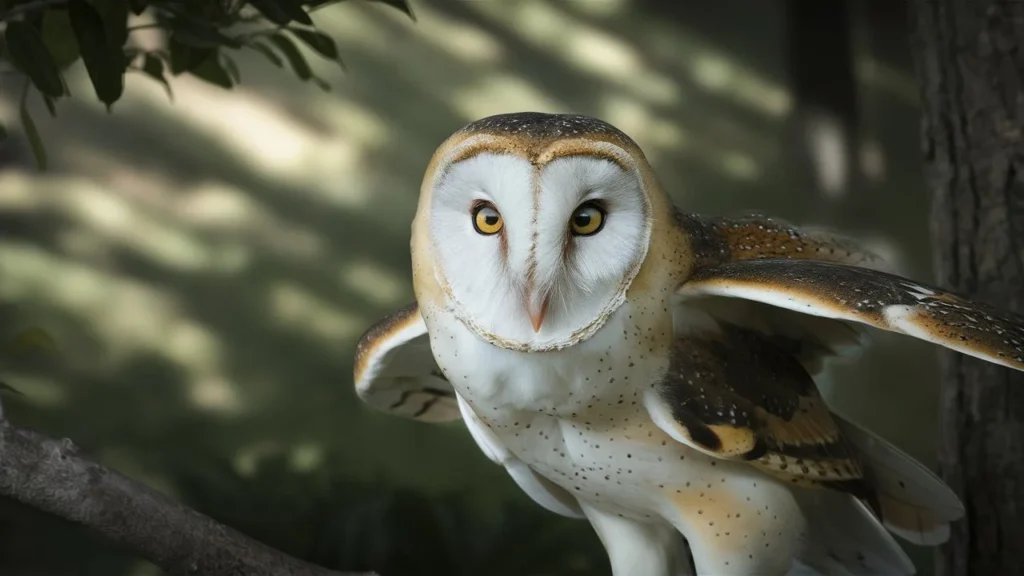
Appearance
The Barn Owl is easy to recognize with its heart-shaped, white face, dark eyes, and golden-brown back feathers mixed with gray and white. Its pale belly and delicate look make it one of the most distinctive owls.
Hunting and Feeding Habits
Barn Owls are excellent nighttime hunters. They use their sharp hearing to locate small animals like mice and voles, even in total darkness. Flying silently, they can sneak up on prey without being detected, catching it with their strong talons.
Nesting
Barn Owls nest in sheltered, quiet places such as tree cavities, barn lofts, or cliffs. They don’t build nests but use existing spots, sometimes lining them with pellets (the undigested parts of their food). They typically lay several eggs, with the chicks hatching at different times.
Migration
Barn Owls are usually not migratory. They stay close to home all year round, although some might move to nearby areas in search of food during harsh winters. They are found on almost every continent and adapt well to a range of climates.
Behavior and Personality
Barn Owls are calm and silent but are also known for their eerie, screeching call. Unlike other owls, they don’t hoot. They are solitary, only seen with a mate during the breeding season, and are generally not aggressive.
Habitat
Barn Owls live in open areas like farmlands, grasslands, and meadows where they can find plenty of small rodents. They also adapt well to human environments and are often seen in barns and abandoned buildings, making them helpful for pest control in agricultural areas.
| Feature | Description |
|---|---|
| Diet | Rodents, small mammals |
| Lifetime | 4-10 years |
| Habitat | Grasslands, farmlands |
| Size | 13-15 inches |
| Unique Trait | Heart-shaped face, silent flight |
3. Elf Owl
Scientific Name: Micrathene whitneyi
Size: 12.5–14.5 cm (5–5.5 in)
Weight: 40–45 g (1.4–1.6 oz)
Lifespan: 3–6 years in the wild
Diet: Insects, spiders, small lizards, and occasionally small mammals

Appearance
The Elf Owl is the smallest owl in the world, with a round head and large, expressive yellow eyes. It has gray-brown feathers with pale streaks, blending well into its desert and woodland habitats. Its small size and gentle expression give it a cute, delicate appearance.
Hunting and Feeding Habits
Elf Owls are insect hunters, feeding primarily at night. They capture moths, beetles, and other insects in flight, using their sharp talons. They are also known to catch small lizards or mice when available, although insects are their main diet.
Nesting
Elf Owls nest in abandoned woodpecker holes in trees or cacti, such as the saguaro cactus in the southwestern U.S. and Mexico. They lay 2–4 eggs, and both parents take turns feeding the chicks. The nests are small and cozy, a perfect fit for these tiny owls.
Migration
Unlike many owls, Elf Owls are migratory. They travel from their breeding grounds in the southwestern U.S. and northern Mexico to warmer areas in southern Mexico during the winter. This migration helps them find food sources year-round.
Behavior and Personality
Elf Owls are gentle and timid, usually avoiding confrontation with larger animals. When threatened, they may pretend to be dead as a defense mechanism. Their high-pitched, rapid calls are often heard in the evening, signaling their activity as they emerge to hunt.
Habitat
Elf Owls are found in desert woodlands, scrublands, and areas with tall cacti. They thrive in warm, dry environments with scattered trees or cacti for nesting. They’re often seen near rivers or washes where insects are more abundant, making these small but resilient owls well-suited to desert life.
| Feature | Description |
|---|---|
| Diet | Insects, small vertebrates |
| Lifetime | 3-6 years |
| Habitat | Desert areas |
| Size | 5-6 inches |
| Unique Trait | Smallest owl, nocturnal hunter |
4. Western Screech Owl
Scientific Name: Megascops kennicottii
Size: 19–25 cm (7.5–10 in)
Weight: 100–250 g (3.5–8.8 oz)
Lifespan: 8–13 years in the wild
Diet: Small mammals, insects, birds, and occasionally fish
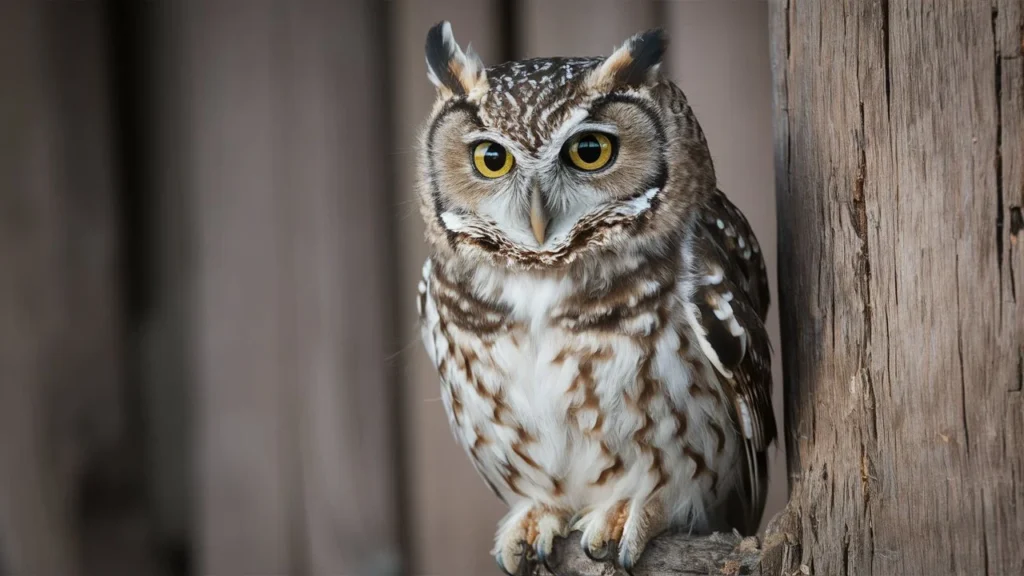
Appearance
The Western Screech Owl has a compact, stocky body with ear tufts that make it look alert. Its feathers are a mottled gray or brown, helping it blend into tree bark. Its bright yellow eyes give it a sharp, watchful expression, while the intricate patterns on its feathers provide excellent camouflage.
Hunting and Feeding Habits
Western Screech Owls are skillful nighttime hunters. They hunt by watching from a perch and silently swooping down to grab prey with their talons. Their diet includes mice, insects, and small birds. They also eat fish or amphibians if they live near water sources.
Nesting
These owls nest in tree cavities, often using holes made by woodpeckers, but they will also use nest boxes if available. They don’t add any nesting material, relying on the natural space. Typically, they lay 3–5 eggs, with both parents helping to care for the young.
Migration
Western Screech Owls are non-migratory and stay within their territory year-round. They adapt well to various environments, from forests to suburban areas, as long as there are trees and adequate food.
Behavior and Personality
Western Screech Owls are territorial and vocal, known for their distinctive trilling or whinnying call, which sounds like a soft, bouncing rhythm rather than a screech. They are solitary and mostly quiet, except during the breeding season or when defending their territory.
Habitat
These owls live in diverse habitats, including woodlands, deserts, and suburban areas. They prefer areas with scattered trees, such as forests, orchards, and even city parks. Western Screech Owls are adaptable, thriving in both wilderness and human-inhabited environments as long as there are places to roost and nest.
| Feature | Description |
|---|---|
| Diet | Insects, small mammals |
| Lifetime | 8-13 years |
| Habitat | Woodlands, suburban areas |
| Size | 7-10 inches |
| Unique Trait | Small, with ear tufts, camouflaged |
5. Burrowing Owl
Scientific Name: Athene cunicularia
Size: 19–25 cm (7.5–10 in)
Weight: 140–240 g (4.9–8.5 oz)
Lifespan: 6–9 years in the wild
Diet: Insects, small mammals, reptiles, and birds
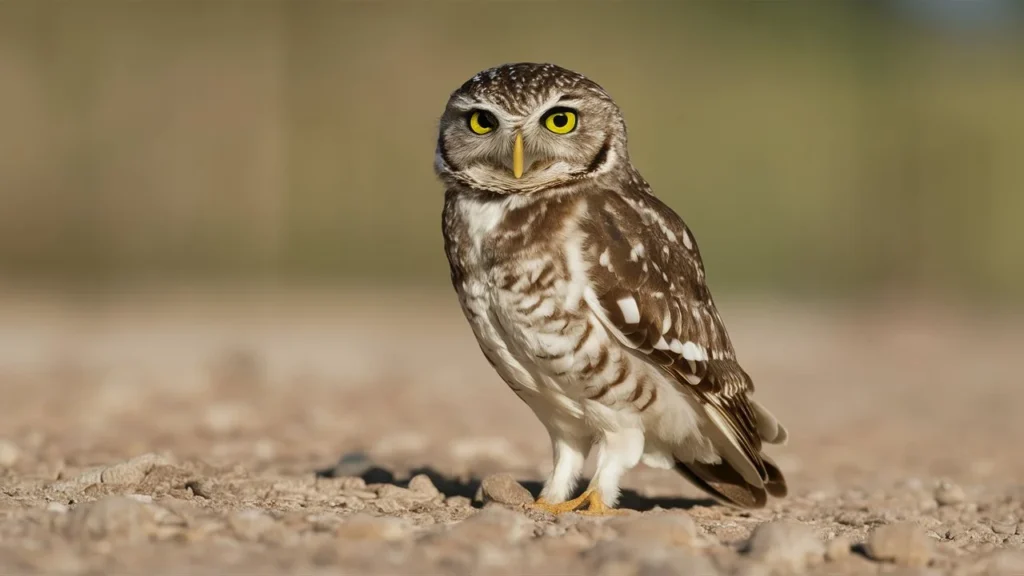
Appearance
The Burrowing Owl has long legs, a round face with bright yellow eyes, and lacks the “horns” or tufts that other owls have. Its brown feathers are speckled with white spots, and it has a pale belly, helping it blend into open, grassy environments.
Hunting and Feeding Habits
Unlike most owls, the Burrowing Owl hunts during the day, especially in the morning and late afternoon. Its diet includes insects like grasshoppers, beetles, and crickets, as well as small animals like mice, lizards, and birds. It catches prey by stalking or pouncing on it from the ground.
Nesting
True to its name, the Burrowing Owl lives in underground burrows. They often use burrows dug by animals like prairie dogs, but they can also dig their own. These owls line their nests with materials like grass, feathers, and even cow dung to attract insects, which they also eat. They usually lay around 6–9 eggs, and both parents help care for the young.
Migration
Northern populations of Burrowing Owls migrate south in the winter, traveling to Mexico and Central America. However, those in warmer climates, like Florida and parts of the Southwest, tend to stay in the same area year-round.
Behavior and Personality
Burrowing Owls are social, often seen in small groups, and can be surprisingly bold around humans. They’re known for bobbing up and down when curious or alarmed. Their calls include soft coos, chirps, and a rattling sound when they feel threatened, creating a range of sounds to communicate.
Habitat
These owls are commonly found in open grasslands, deserts, and agricultural fields where they can easily spot prey. They thrive in flat, treeless areas and are frequently seen near burrows, scanning for food or guarding their nests. This makes them well-suited to open landscapes with plenty of ground cover.
| Feature | Description |
|---|---|
| Diet | Insects, small mammals |
| Lifetime | 6-8 years |
| Habitat | Grasslands, deserts |
| Size | 7-10 inches |
| Unique Trait | Lives in burrows, diurnal activity |
6. Northern Pygmy Owl
Scientific Name: Glaucidium californicum
Size: 16–18 cm (6.5–7 in)
Weight: 60–75 g (2.1–2.6 oz)
Lifespan: 6–8 years in the wild
Diet: Small birds, mammals, insects, and reptiles
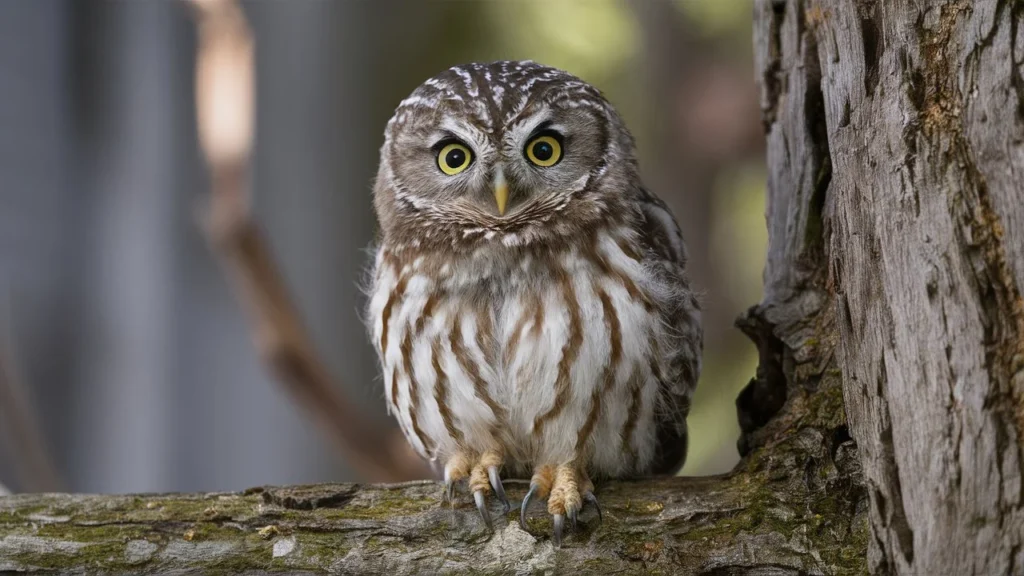
Appearance
The Northern Pygmy Owl is tiny but fierce, with a round head, no ear tufts, and bright yellow eyes. Its feathers are a mix of brown and gray, with white spots on its head and a striped tail. A unique feature is the pair of black “eye spots” on the back of its head, which helps deter predators.
Hunting and Feeding Habits
This little owl is an active daytime hunter. It preys on small birds, mice, insects, and even lizards. Known for its surprising strength, the Northern Pygmy Owl often catches prey close to its size. It hunts from a perch, quickly swooping down to grab its target with sharp talons.
Nesting
Northern Pygmy Owls nest in tree cavities, usually using old woodpecker holes. They don’t add any nesting material to the cavity. Typically, they lay 3–7 eggs, and the female incubates them while the male provides food. The chicks hatch after about a month and stay in the nest for several weeks.
Migration
Northern Pygmy Owls are generally non-migratory, staying within their territory throughout the year. However, some may move slightly downslope in winter to avoid the harshest mountain conditions.
Behavior and Personality
Despite their small size, Northern Pygmy Owls are bold and fearless, often taking on prey close to their own size. Their call is a high-pitched, repetitive “toot-toot,” which can be heard echoing through forests. These owls are territorial and will defend their hunting grounds against intruders.
Habitat
These owls are typically found in forested mountain areas, especially near the edges of clearings or open spaces where prey is plentiful. They prefer mixed coniferous and deciduous forests and can be seen from lowland forests to high-elevation woodlands. Their adaptability and daytime hunting make them unique among owls in their range.
| Feature | Description |
|---|---|
| Diet | Small birds, mammals, insects |
| Lifetime | 6-7 years |
| Habitat | Forests, woodlands |
| Size | 6-7 inches |
| Unique Trait | Tiny, diurnal hunter |
7. Long-eared Owl
Scientific Name: Asio otus
Size: 31–40 cm (12–16 in)
Weight: 220–435 g (7.8–15.3 oz)
Lifespan: 10–15 years in the wild
Diet: Primarily small mammals like mice and voles, occasionally small birds
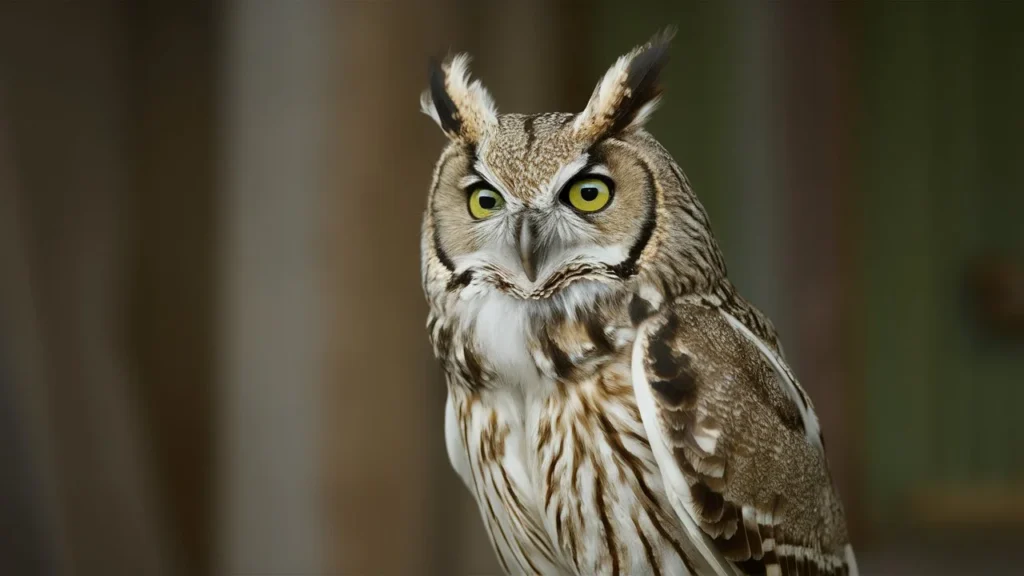
Appearance
The Long-eared Owl is known for its tall, slender build and prominent “ear” tufts that give it a distinctive look, though they aren’t actual ears. Its feathers are mottled brown and gray, with a pale face and bright yellow-orange eyes. This camouflage helps it blend well into dense foliage.
Hunting and Feeding Habits
This owl is a nighttime hunter, relying on its sharp hearing and silent flight to catch prey, mainly small rodents. It hunts by flying low over open areas or perching and listening for movement before swooping down. Long-eared Owls often swallow smaller prey whole and later regurgitate pellets.
Nesting
Long-eared Owls don’t build their own nests but instead use old nests from other birds, such as crows or hawks. They often nest in dense thickets or coniferous trees, laying 3–8 eggs. Both parents help care for the young until they’re ready to leave the nest.
Migration
While some Long-eared Owls remain in their territories year-round, many migrate south in the winter, especially those living in colder northern regions. They migrate to find more favorable hunting conditions and often roost in groups during this season.
Behavior and Personality
Long-eared Owls are generally shy and secretive, especially during the day. They tend to roost in dense vegetation to stay hidden. During the breeding season, males perform impressive aerial displays and emit a series of low hoots to attract mates. They are more social in winter, often gathering in communal roosts.
Habitat
Long-eared Owls prefer wooded areas with dense trees for roosting and nearby open fields for hunting. They are commonly found in mixed forests, farmlands, grasslands, and areas near bodies of water. Their adaptability and excellent camouflage help them stay concealed in a range of environments across North America, Europe, and Asia.
| Feature | Description |
|---|---|
| Diet | Small mammals, birds |
| Lifetime | 10-15 years |
| Habitat | Woodlands, dense forests |
| Size | 13-16 inches |
| Unique Trait | Long ear tufts, nocturnal |
8. Short-eared Owl
Scientific Name: Asio flammeus
Size: 34–43 cm (13–17 in)
Weight: 206–475 g (7.3–16.8 oz)
Lifespan: 4–12 years in the wild
Diet: Primarily small mammals, especially voles, but also insects and birds
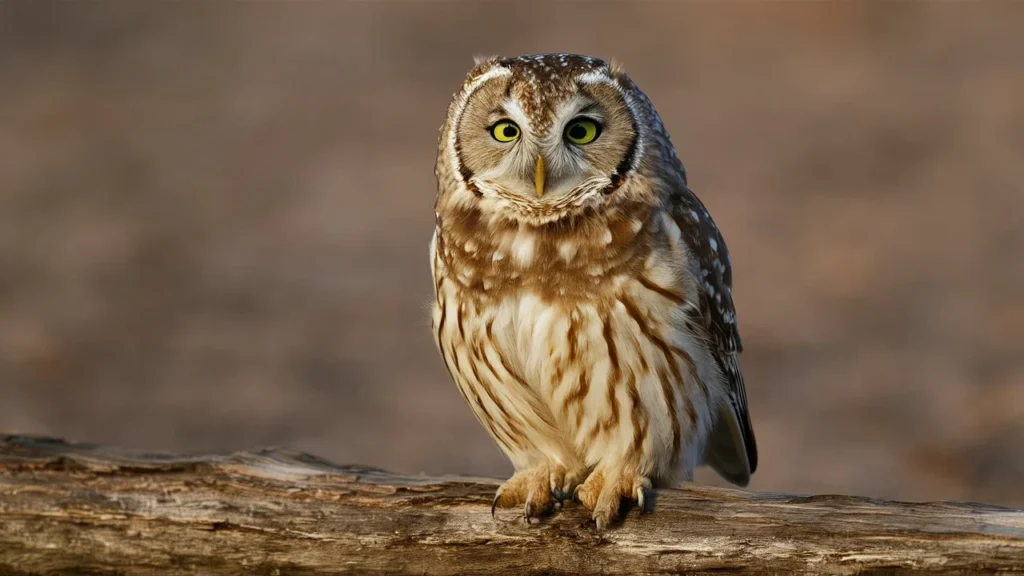
Appearance
The Short-eared Owl is a medium-sized owl with short, barely visible ear tufts, giving it a rounded head appearance. Its feathers are a mix of mottled brown, buff, and white, with striking yellow eyes surrounded by black circles, adding to its intense look. Its broad wings and short tail make it well-suited for flying over open landscapes.
Hunting and Feeding Habits
Unlike many owls, the Short-eared Owl is active during the day, especially at dawn and dusk. It hunts by flying low over open fields, using its keen sight and hearing to locate prey. It primarily eats small mammals, especially voles, but will also catch birds and large insects when available.
Nesting
Short-eared Owls nest on the ground, often in grassy or marshy areas. The female scrapes out a shallow depression and lines it with grass, feathers, and other soft materials. They usually lay 4–7 eggs, and the female incubates them while the male brings food. The young leave the nest after a few weeks but stay nearby until they can hunt on their own.
Migration
Short-eared Owls are partially migratory, depending on food availability. Northern populations often move south for the winter, while others may stay in the same area year-round if food is abundant. They are also known to wander, sometimes showing up in unexpected locations outside their usual range.
Behavior and Personality
These owls are bold and highly adaptable, often seen flying over open fields in search of prey. Their flight is buoyant and moth-like, with slow wingbeats, making them easy to spot. Short-eared Owls are territorial during the breeding season but more social in winter, sometimes forming small roosting groups.
Habitat
Short-eared Owls favor open habitats, including grasslands, prairies, marshes, and coastal dunes. They are also found in agricultural fields and tundra, adapting well to areas with low vegetation that provides clear views of potential prey. Their widespread distribution includes North and South America, Europe, Asia, and some island regions.
| Feature | Description |
|---|---|
| Diet | Small mammals, birds |
| Lifetime | 4-12 years |
| Habitat | Open fields, grasslands |
| Size | 13-17 inches |
| Unique Trait | Round face, active at dusk and dawn |
9. Spotted Owl
Scientific Name: Strix occidentalis
Size: 43–48 cm (17–19 in)
Weight: 500–700 g (1.1–1.5 lbs)
Lifespan: 15–20 years in the wild
Diet: Small mammals, especially flying squirrels and wood rats, along with birds, insects, and reptiles
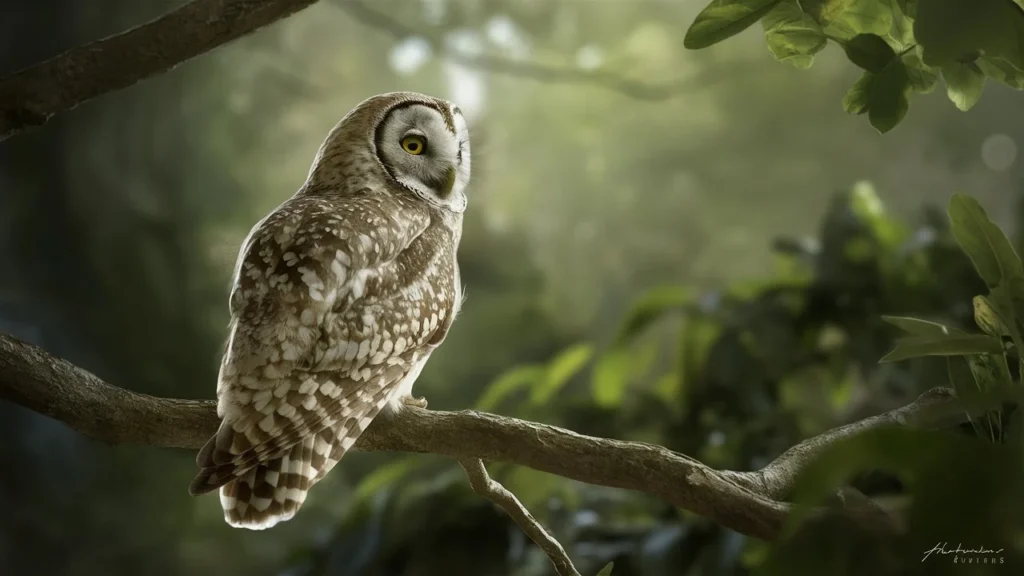
Appearance
The Spotted Owl has dark brown feathers with distinctive white spots on its head, back, and chest, giving it a speckled appearance. Its large, dark eyes stand out against its pale facial disk, and its rounded head has no ear tufts. This owl’s plumage provides excellent camouflage in dense, forested habitats.
Hunting and Feeding Habits
Spotted Owls are primarily nocturnal hunters, relying on stealth and acute hearing to locate prey. They prefer small mammals, such as flying squirrels and wood rats, which they capture in silent, swooping flights. They sometimes hunt from a perch, scanning and listening for any movement below.
Nesting
These owls don’t build their own nests; instead, they use tree cavities, old nests of other birds, or natural depressions in trees. They usually lay 2–3 eggs, with the female incubating while the male brings food. Both parents participate in feeding and protecting the young once they hatch.
Migration
Spotted Owls are generally non-migratory and stay within their home ranges year-round. They establish and defend territories, although they may shift to lower elevations or move short distances to find food in winter.
Behavior and Personality
Spotted Owls are known for their calm, territorial nature, often remaining in the same area for years. They communicate with a series of deep hoots and whistles, especially during the breeding season. These owls are also sensitive to disturbance and prefer quiet, undisturbed habitats, making them particularly vulnerable to habitat loss.
Habitat
Spotted Owls inhabit old-growth forests with large trees and dense canopies, particularly in the western United States and parts of Mexico. They prefer habitats with abundant cover and nesting sites, usually in mature forests with a mix of coniferous and deciduous trees. Due to their specialized habitat needs, they are considered an indicator species for forest health and are protected under conservation efforts.
| Feature | Description |
|---|---|
| Diet | Small mammals, birds |
| Lifetime | 10-15 years |
| Habitat | Dense forests, canyons |
| Size | 17-19 inches |
| Unique Trait | Dark eyes, spotted feathers |
10. Mexican Spotted Owl
Scientific Name: Strix occidentalis lucida
Size: 43–48 cm (17–19 in)
Weight: 500–700 g (1.1–1.5 lbs)
Lifespan: 15–20 years in the wild
Diet: Primarily small mammals, especially wood rats, along with birds, insects, and reptiles
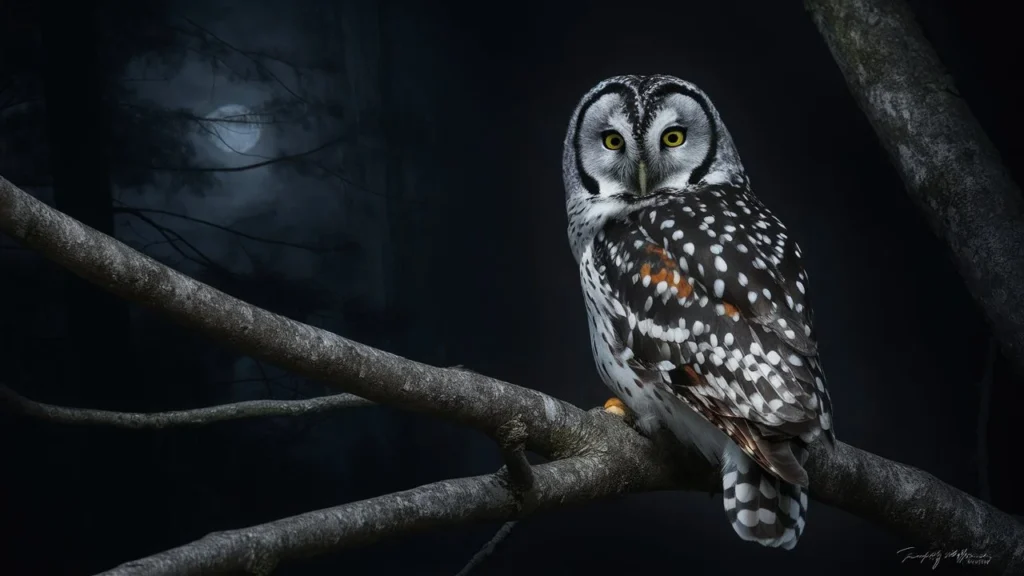
Appearance
The Mexican Spotted Owl, a subspecies of the Spotted Owl, has a similar dark brown and white-speckled appearance, but its spots are more prominent and widespread across its body. It has large, dark eyes and a rounded face without ear tufts, with pale, spotted plumage that provides camouflage in forested and rocky habitats.
Hunting and Feeding Habits
This owl is a skilled nighttime hunter, preying mainly on small mammals like wood rats and squirrels. It hunts from perches, silently swooping down to capture its prey. Occasionally, it also feeds on birds, reptiles, and large insects, using its sharp hearing to detect movements below.
Nesting
Mexican Spotted Owls nest in natural cavities in large trees, rock crevices, or old nests built by other birds. They prefer high, sheltered sites within dense forests or canyon walls. The female incubates 2–4 eggs while the male brings food, and both parents care for the young after hatching.
Migration
Mexican Spotted Owls are generally non-migratory, staying within their territory year-round. However, some may move slightly to lower elevations in winter, especially if food is scarce or weather conditions become too harsh in their usual habitats.
Behavior and Personality
Mexican Spotted Owls are calm, territorial, and known to remain in the same area throughout their lives if conditions are stable. Their calls are deep, resonant hoots, often heard at dusk and dawn during the breeding season. They are highly sensitive to disturbances, requiring quiet, protected environments for breeding.
Habitat
This owl subspecies prefers old-growth forests and rugged canyons in the southwestern United States and Mexico. It thrives in mixed coniferous and deciduous forests, especially in areas with steep cliffs or canyons that provide secluded nesting spots. Due to their dependence on specific habitats, Mexican Spotted Owls are considered a threatened species, and conservation efforts focus on protecting their forested and canyon habitats from logging and development.
| Feature | Description |
|---|---|
| Diet | Small mammals, birds |
| Lifetime | 10-15 years |
| Habitat | Canyons, forests |
| Size | 17-19 inches |
| Unique Trait | Lighter spots, conservation priority |
11. Northern Saw-whet Owl
Scientific Name: Aegolius acadicus
Size: 17–22 cm (6.7–8.7 in)
Weight: 54–151 g (1.9–5.3 oz)
Lifespan: 7–10 years in the wild
Diet: Primarily small mammals, especially mice and voles, and occasionally birds and insects
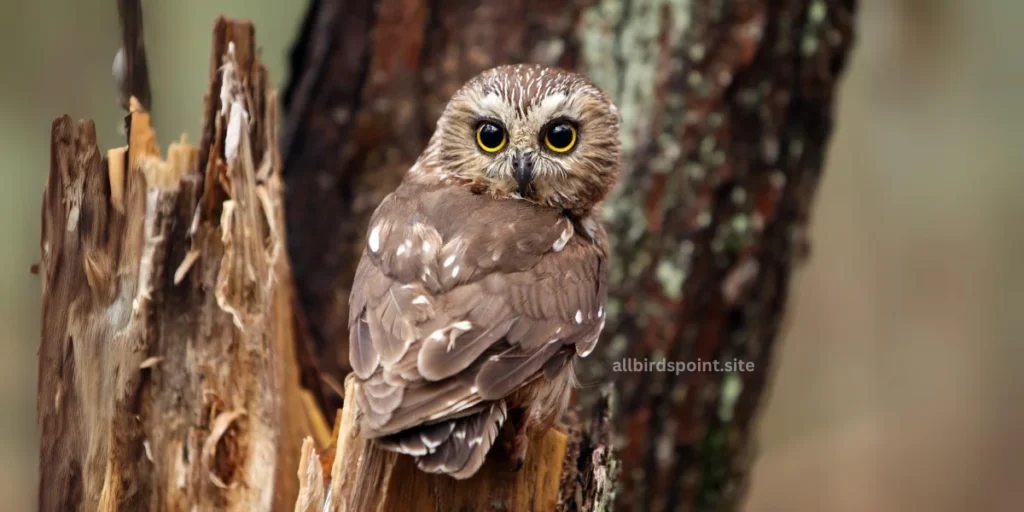
Appearance
The Northern Saw-whet Owl is a small, round owl with a large head and no ear tufts. It has big, bright yellow eyes and brown feathers streaked with white, giving it an expressive look. Its name comes from its call, which resembles the sound of a saw being sharpened, or “whetted.”
Hunting and Feeding Habits
This owl is a skilled nighttime hunter, using its excellent hearing to locate prey in low light. It mainly feeds on small mammals, especially mice, which it catches by swooping down from a perch. Occasionally, it also eats small birds or large insects. The owl often swallows its prey whole and later regurgitates the indigestible parts as pellets.
Nesting
Northern Saw-whet Owls nest in tree cavities, especially those abandoned by woodpeckers. They may also use nest boxes if available. The female incubates 4–7 eggs, while the male hunts and brings food. Once hatched, both parents care for the chicks until they are old enough to leave the nest.
Migration
Northern Saw-whet Owls are partially migratory, with northern populations moving south in the winter. Their migration patterns are influenced by food availability, and some may travel quite far to find adequate resources during colder months.
Behavior and Personality
These owls are secretive and generally quiet outside of the breeding season. During the breeding season, males call out with a rhythmic, tooting sound to attract mates. Northern Saw-whet Owls are also known for their calm demeanor and are generally tolerant of human observers, although their small size and excellent camouflage make them hard to spot.
Habitat
Northern Saw-whet Owls are found in a variety of forested habitats, including coniferous, deciduous, and mixed woodlands. They prefer dense forests with plenty of cover for roosting during the day and open spaces nearby for hunting at night. These adaptable owls are distributed across North America, from southern Canada to the northern United States, thriving in both wild and semi-urban areas with suitable trees for nesting.
| Feature | Description |
|---|---|
| Diet | Small mammals, birds, insects |
| Lifetime | 7-10 years |
| Habitat | Dense forests, woodlands |
| Size | 7-8 inches |
| Unique Trait | Big head, saw-like call |
12. Flammulated Owl
Scientific Name: Psiloscops flammeolus
Size: 15–17 cm (6–7 in)
Weight: 45–63 g (1.6–2.2 oz)
Lifespan: 5–8 years in the wild
Diet: Primarily insects, including moths, beetles, and other small arthropods
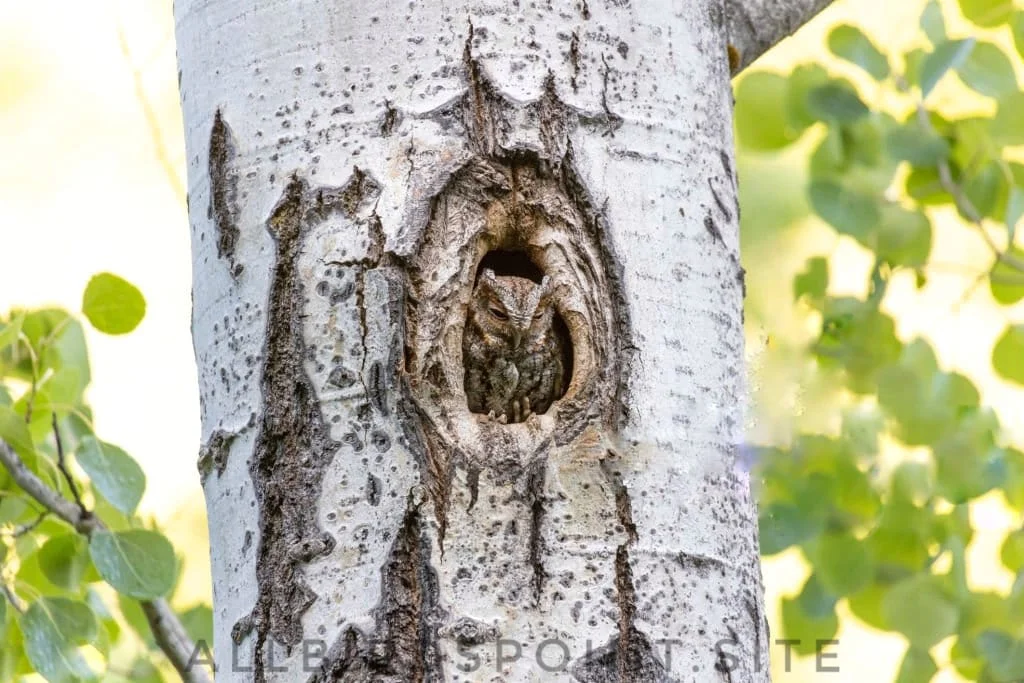
Appearance
The Flammulated Owl is small, with a compact body and short, rounded wings. Its name comes from its flame-like markings: reddish-brown and gray feathers with streaks that help it blend perfectly into tree bark. It has dark eyes, a distinguishing feature among owls in North America, and small ear tufts that are often hard to see.
Hunting and Feeding Habits
This owl feeds mostly at night, hunting for insects by either catching them in mid-air or snatching them off leaves and branches. Its diet consists primarily of moths, beetles, and other small insects. It is an agile flier, and its silent flight helps it capture prey undetected.
Nesting
Flammulated Owls nest in tree cavities, often using old woodpecker holes. They don’t build nests but may line the cavity floor with a few feathers. The female typically lays 2–4 eggs, which she incubates while the male provides food. Both parents care for the young once they hatch.
Migration
Flammulated Owls are migratory, moving from their breeding grounds in western North America to wintering areas in Central America. They are one of the few owl species that migrate long distances, and they travel south in the fall to find food and suitable habitats for the winter.
Behavior and Personality
These owls are secretive and well-camouflaged, making them challenging to spot. They are known for their soft, low hoots, often given in a repetitive pattern during the breeding season. Flammulated Owls are generally solitary and prefer to stay hidden in dense forest cover during the day, becoming active only at night.
Habitat
Flammulated Owls prefer montane forests, particularly open coniferous forests with plenty of pine and aspen trees. They are typically found in mountainous areas and choose habitats with dense cover for roosting and open spaces for hunting. Their range includes parts of the western United States and into Mexico, where they breed in high-elevation forests.
| Feature | Description |
|---|---|
| Diet | Insects |
| Lifetime | 7–10 years |
| Habitat | Forests, woodlands |
| Size | 6–7 inches |
| Unique Trait | Reddish coloring, insect eater |
13. Whiskered Screech Owl
Scientific Name: Megascops trichopsis
Size: 16–20 cm (6.3–8 in)
Weight: 80–120 g (2.8–4.2 oz)
Lifespan: 6–8 years in the wild
Diet: Insects, small mammals, and occasionally small birds
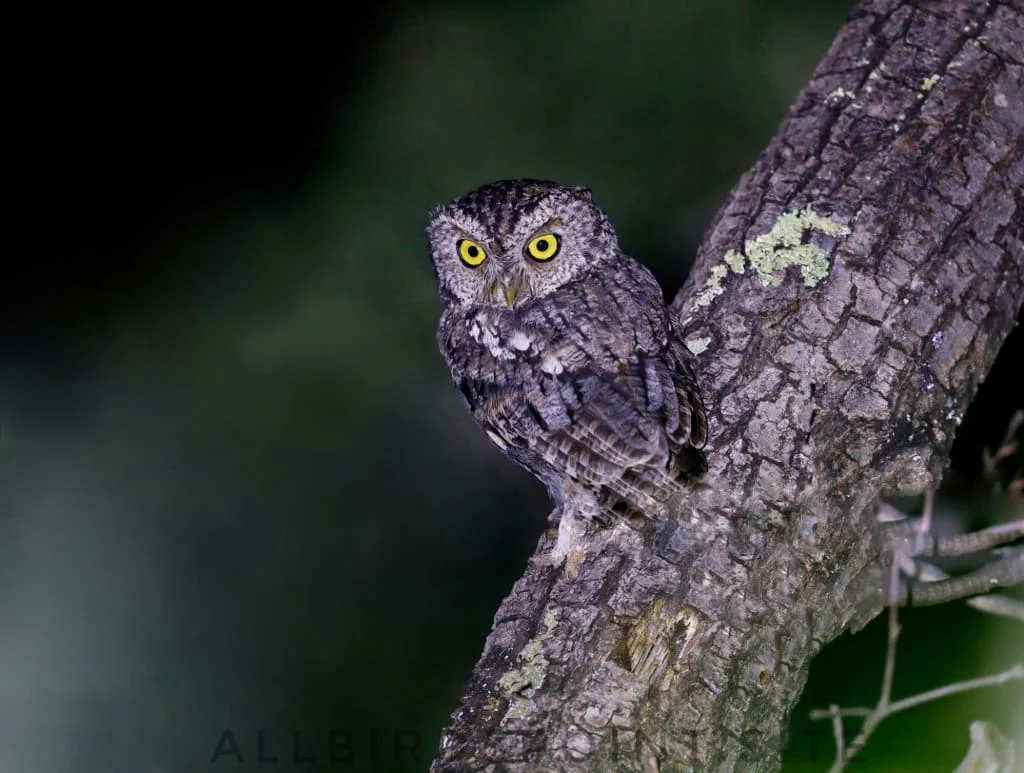
Appearance
The Whiskered Screech Owl is a small owl with distinctive “whiskers” – bristly feathers around its face that give it a unique, expressive look. It has a rounded head with prominent ear tufts, mottled gray and brown plumage with white streaks, and yellow eyes, providing excellent camouflage in its forest habitat.
Hunting and Feeding Habits
This owl is primarily an insectivore, feeding on large insects such as moths, beetles, and crickets. It hunts at night, perching quietly and using its sharp vision and hearing to locate prey before swooping down. Occasionally, it also eats small mammals or birds.
Nesting
Whiskered Screech Owls nest in tree cavities, often using abandoned woodpecker holes. They do not add any nesting material, relying on the natural hollow of the tree. The female lays 2–4 eggs, which she incubates while the male provides food. Once hatched, both parents feed the young until they are ready to leave the nest.
Migration
Whiskered Screech Owls are generally non-migratory, remaining in their territory year-round. However, they may move short distances in response to food availability or seasonal weather changes in mountainous areas.
Behavior and Personality
These owls are territorial and are known for their repetitive, soft trilling call, which they use during the breeding season to establish territory and attract mates. They are secretive and well-camouflaged, often blending into tree bark during the day. They are relatively solitary and are active mostly at night.
Habitat
Whiskered Screech Owls are found in montane forests, particularly in pine-oak woodlands at higher elevations. They prefer areas with dense trees and thick vegetation, often in mountainous regions of Mexico and parts of the southwestern United States. Their choice of habitat provides ample cover for roosting and hunting, making them well-suited to forested landscapes.
| Feature | Description |
|---|---|
| Diet | Insects, small vertebrates |
| Lifetime | 5–8 years |
| Habitat | Mountain forests |
| Size | 6–8 inches |
| Unique Trait | Whisker-like feathers, trilling call |
14. Ferruginous Pygmy Owl
Scientific Name: Glaucidium brasilianum
Size: 15–18 cm (6–7 in)
Weight: 60–75 g (2.1–2.6 oz)
Lifespan: 7–10 years in the wild
Diet: Primarily insects, small birds, reptiles, and small mammals

Appearance
The Ferruginous Pygmy Owl is a small owl with reddish-brown (ferruginous) plumage, spotted with white on its head and back. It has large yellow eyes and a rounded head without ear tufts. Notably, it has black “eye spots” on the back of its head, which help deter predators by giving the illusion of being watched.
Hunting and Feeding Habits
This owl is a versatile, active hunter, primarily feeding on insects, small birds, lizards, and small mammals. It hunts during the day and at dusk, often seen perched in open areas scanning for prey. It captures prey with swift, direct flights or by diving from a perch to snatch it on the ground.
Nesting
Ferruginous Pygmy Owls nest in tree cavities, often using abandoned woodpecker holes or natural hollows in trees. They don’t add nesting material, relying on the existing hollow. The female typically lays 3–5 eggs, which she incubates while the male provides food. Both parents care for the chicks once they hatch.
Migration
This species is generally non-migratory, staying within its range throughout the year. It can be found across a wide distribution from the southwestern United States through Central America and into parts of South America.
Behavior and Personality
Ferruginous Pygmy Owls are known for their bold, curious personalities despite their small size. They are often fearless, even attacking larger birds to defend their territory. They are vocal, with a high-pitched, repetitive whistling call, and are especially active during dawn and dusk, although they are frequently seen in the daytime as well.
Habitat
Ferruginous Pygmy Owls inhabit a variety of environments, including forests, scrublands, deserts, and semi-open woodlands. They prefer areas with scattered trees and shrubs that provide cover and suitable perches for hunting. These adaptable owls can thrive in diverse habitats across their range, from dense forests to urban edges, making them a common sight in many regions.
| Feature | Description |
|---|---|
| Diet | Small birds, insects |
| Lifetime | 4–7 years |
| Habitat | Deserts, woodlands |
| Size | 6–7 inches |
| Unique Trait | Reddish-brown, diurnal hunter |
15. Great Gray Owl
Scientific Name: Strix nebulosa
Size: 61–84 cm (24–33 in)
Weight: 790–1,450 g (1.7–3.2 lbs)
Lifespan: 12–15 years in the wild
Diet: Primarily small mammals like voles, along with shrews, squirrels, and occasionally birds
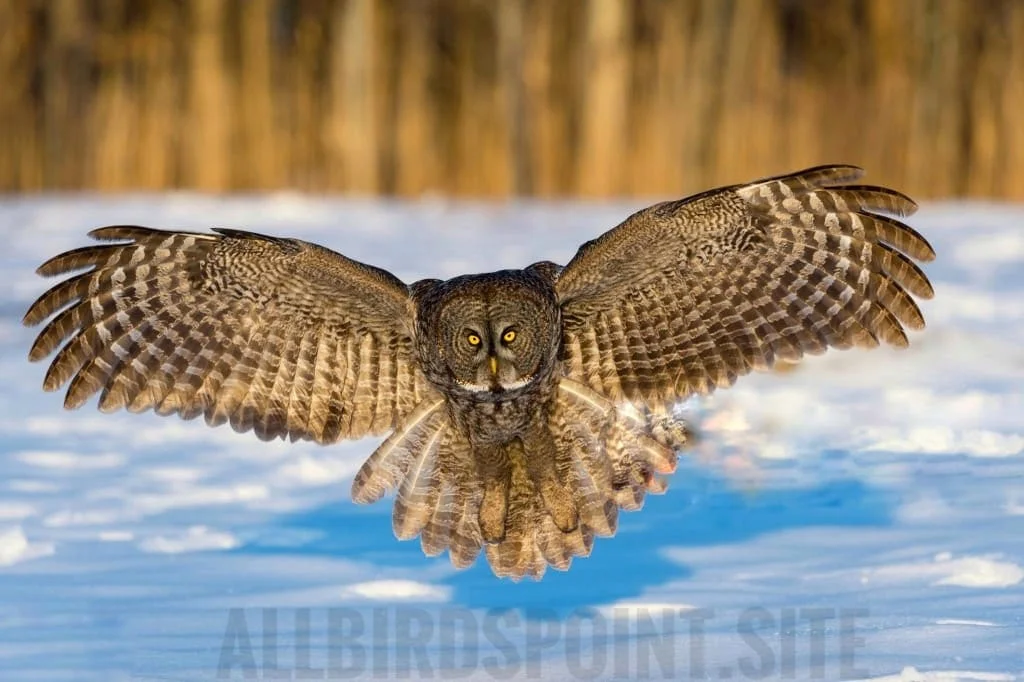
Appearance
The Great Gray Owl is the tallest owl in North America, with a round face framed by a large, circular facial disk and no ear tufts. Its feathers are a mix of gray, brown, and white, giving it a silvery appearance. It has piercing yellow eyes, and its long tail and dense plumage make it appear larger than it actually is.
Hunting and Feeding Habits
This owl is a patient, stealthy hunter, relying on its incredible hearing to detect small mammals moving under thick snow or brush. It typically hunts from a perch, diving down with precision to capture prey. Voles make up the majority of its diet, although it will eat other small mammals and birds if available.
Nesting
Great Gray Owls typically nest in abandoned nests built by other large birds, such as hawks or ravens, or in broken tree tops. They may also nest on the ground or use artificial nesting platforms if available. The female usually lays 2–5 eggs, and both parents work together to protect and feed the young.
Migration
Great Gray Owls are generally non-migratory, remaining within their northern territories year-round. However, some may move short distances southward during harsh winters if food becomes scarce, often leading to “irruption” years when they appear farther south in greater numbers.
Behavior and Personality
Despite their imposing size, Great Gray Owls are calm and gentle. They are mostly silent, communicating through soft hoots and whistles, and are more vocal during the breeding season. These owls are also elusive and tend to avoid humans, making sightings rare.
Habitat
Great Gray Owls prefer dense boreal forests near open meadows, bogs, or forest edges, where they have access to both cover and hunting grounds. They are commonly found in northern North America and parts of Eurasia, thriving in coniferous and mixed forests with large, open hunting areas nearby. This owl’s preference for remote, wild habitats makes it particularly sensitive to environmental changes.
| Feature | Description |
|---|---|
| Diet | Small mammals, birds |
| Lifetime | 10–15 years |
| Habitat | Dense forests, mountains |
| Size | 24–33 inches |
| Unique Trait | Largest owl, silent flight |
Summary
Arizona’s remarkable range of habitats provides a haven for a wide array of owl species, each adapted to different landscapes and displaying unique characteristics that make them captivating to study and observe. In the arid deserts, you might spot small, resilient species like the Elf Owl, while dense forests offer a habitat for larger, elusive species such as the Great Horned Owl. Grasslands, too, support these incredible birds, providing open spaces for hunting and nesting.
Owls play an essential role in Arizona’s ecosystems, helping to control populations of small mammals and insects, which benefits the balance of local habitats. Their adaptability to diverse environments and specialized hunting skills highlight the incredible biodiversity of the region. For birdwatchers, photographers, and nature lovers, Arizona’s owls offer an unparalleled experience, bringing awe and appreciation for the natural world.
What kind of owls are in Arizona?
Arizona has many owls, including the Great Horned Owl, Barn Owl, Elf Owl, Burrowing Owl, and more.
What is the giant owl in Arizona?
The Great Gray Owl is the largest owl in Arizona.
Are owls protected in Arizona?
Yes, some owls, like the Mexican Spotted Owl, are protected due to their threatened status.
FAQs About Owls in Arizona
1. What is the most common owl in Arizona?
The most common owl in Arizona is the Great Horned Owl. It can be found in many different habitats across the state.
2. When is the best time to see owls in Arizona?
Owls are most active at dusk and night. Early evening and just before dawn are the best times to spot them.
3. Where can I find Burrowing Owls in Arizona?
Burrowing Owls are usually found in open grasslands and deserts. Look for them around the edges of burrows they live in.
4. What do owls in Arizona eat?
Owls in Arizona eat a variety of things depending on their species. Common diets include small mammals, insects, and birds.
5. Are there any endangered owls in Arizona?
Yes, the Mexican Spotted Owl is considered a threatened species and is protected due to habitat loss.
6. How can I attract owls to my backyard?
To attract owls, provide a safe and quiet environment with tall trees or suitable nesting boxes. Avoid bright lights and loud noises.
7. Do owls migrate in Arizona?
Some owls, like the Short-eared Owl, migrate seasonally, while others, such as the Great Horned Owl, stay in Arizona year-round.
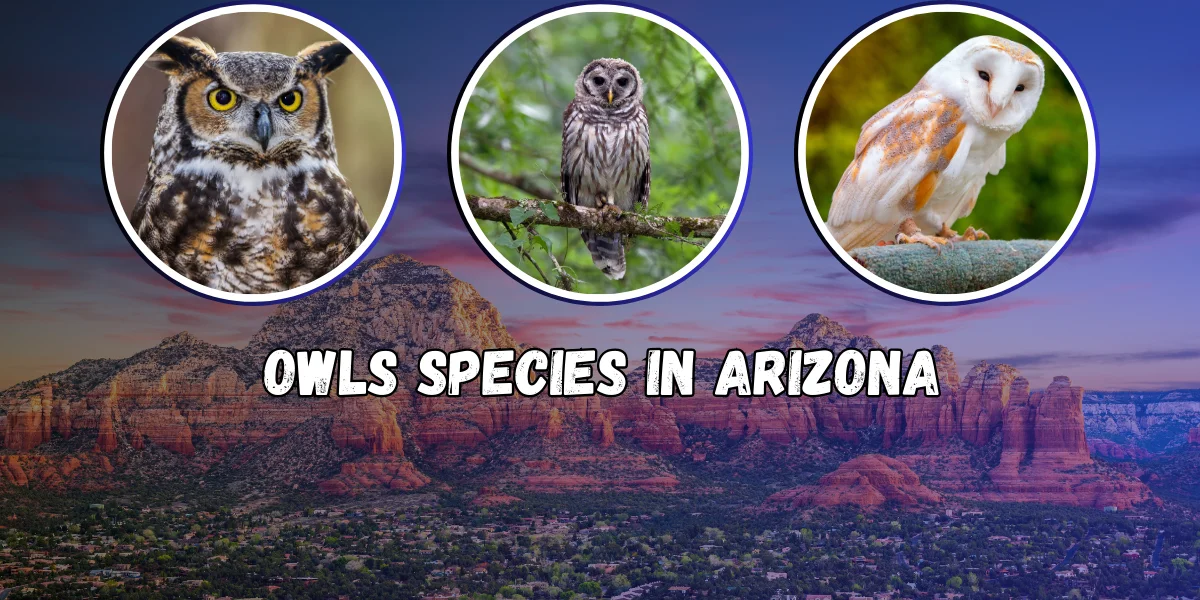
4 thoughts on “Top 15 Owls Species In Arizona: Details, List & Photos”